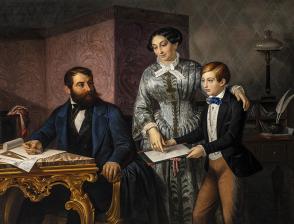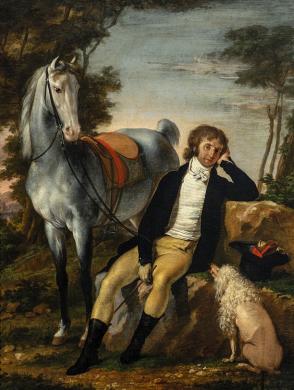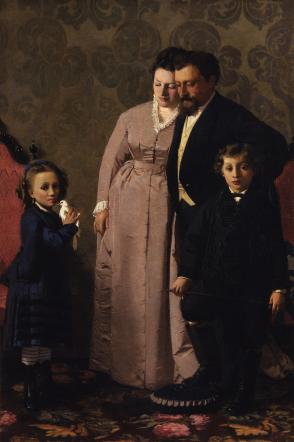The nineteenth century in Italy, a pivotal era marked by profound social, political, and economic shifts, also played a crucial role in the evolution of Italian painting. This century witnessed a diverse array of individuals – liberals, patriots, revolutionaries, reactionaries, nobles, bourgeois, intellectuals, and artists - spanning various artistic movements from Romanticism, Neoclassicism, Realism, Verism, to the brink of the avant-garde. Notably, it saw the establishment of picture galleries, civic museums, and the Venice Biennale.
 The nineteenth-century Venetian portrait endeavours to narrate the story of the contemporary age’s inaugural century. In Venice, this era commenced with the fall of the Serenissima and involved the entire country with the Restoration, the upheavals of 1848, the Risorgimento, and the unification of Italy.
The nineteenth-century Venetian portrait endeavours to narrate the story of the contemporary age’s inaugural century. In Venice, this era commenced with the fall of the Serenissima and involved the entire country with the Restoration, the upheavals of 1848, the Risorgimento, and the unification of Italy.
Our extensive research originated from the exhibition that the first director of Ca’ Pesaro, Nino Barbantini, organised in just a few months in 1923 in the wake of his initial and brilliant idea. Regarded as a cornerstone by art historians, this exhibition has, for the first time, been revisited to illuminate its discoveries, anticipations, and even its errors.
 Barbantini conceived and organised the exhibition at Ca’ Pesaro in the course of a hectic summer, achieving a very great success, exhibiting 241 works by 50 artists. The exhibition was also a fundamental initiative in terms of museography, opening the way to a new type of exhibition, dedicated to artists and themes of the past. Moreover, it was a great success with the public (over 8,000 visitors) and was widely acclaimed in the press of the time. At the same time, it proved to be a fundamental milestone in the history of Ca’ Pesaro itself, which collected important donations and acquisitions of nineteenth-century art, and thus increasingly moved towards its status as museum.
Barbantini conceived and organised the exhibition at Ca’ Pesaro in the course of a hectic summer, achieving a very great success, exhibiting 241 works by 50 artists. The exhibition was also a fundamental initiative in terms of museography, opening the way to a new type of exhibition, dedicated to artists and themes of the past. Moreover, it was a great success with the public (over 8,000 visitors) and was widely acclaimed in the press of the time. At the same time, it proved to be a fundamental milestone in the history of Ca’ Pesaro itself, which collected important donations and acquisitions of nineteenth-century art, and thus increasingly moved towards its status as museum.
Basing ourselves on the success of 1923, we set out to find the works exhibited a century ago and re-propose them in the same location. We found more than 170 paintings and revised some attributions, dates and titles, thanks also to the collaboration of a large group of researchers who wrote up the entries for the monumental exhibition catalogue. The 1923 exhibition had acted as a forerunner for studies of a century that is sometimes overlooked by scholars and which bore the weight of faith: faithfulness first and foremost towards the Old Masters of art, a sentiment that had made it impossible to adopt fresh viewpoints. Today, instead, we have re-examined works and artists starting from the sources and trying to reconstruct the quality and beauty of the Veneto’s nineteenth-century portrait production as much as possible.
 The exhibition at Ca’ Pesaro unveils faces and garments that chronicle a century, weaving connections among families and artists pivotal to the era. Visitors embark on a journey through renowned artists such as Matteini, Hayez, Lipparini, Grigoletti, Schiavoni, Molmenti, and Favretto, capturing the essence of society, the spirit of the age, and its transformative moments: a legacy of images of families, intellectuals, artists, patriots, women – some, artists in their turn. People who animated the territory from Venice, a central meeting point, to Padua, Vicenza, Bassano del Grappa, Pordenone, Trieste, Trento, Treviso and Belluno.
The exhibition at Ca’ Pesaro unveils faces and garments that chronicle a century, weaving connections among families and artists pivotal to the era. Visitors embark on a journey through renowned artists such as Matteini, Hayez, Lipparini, Grigoletti, Schiavoni, Molmenti, and Favretto, capturing the essence of society, the spirit of the age, and its transformative moments: a legacy of images of families, intellectuals, artists, patriots, women – some, artists in their turn. People who animated the territory from Venice, a central meeting point, to Padua, Vicenza, Bassano del Grappa, Pordenone, Trieste, Trento, Treviso and Belluno.
The exhibition is divided into four large sections, which present the nineteenth century through the artists and historical events that necessarily influenced their lives and style of painting. Empire green accompanies visitors in the first section, The dawn of a new century, dedicated to the two founders of the renewed Accademia di Belle Arti di Venezia, Matteini and Querena. Biedermeier yellow runs through the second large section called The great protagonists, with the Romantic and international nineteenth century of Hayez alongside the only foreigner envisaged by Barbantini in 1923, Joseph-Desiré Court. In the same section, there are significant in-depth studies dedicated to individual artists, almost like monographic exhibitions within the exhibition, with great prominence given to the rediscovered production of Lipparini, flanked by the fine works of Perlotto and Rizzoli. Another monographic room is dedicated to Grigoletti, and this is followed by the third section of the exhibition, characterised by blue entitled Images of the mid-century bourgeoisie.
 Starting with the extraordinary artistic and family history of the Schiavoni, a true dynasty of artists, the nineteenth century fascinates and appeals with the works of artists who portray the protagonists of Venetian society, from Giustina Renier Michiel to Count Giovanni Papadopoli. At the same time, the exhibition offers unforgettable images of the landed bourgeoisie depicted in moments of domestic intimacy. The last section of the exhibition, with walls painted in an intense Pompeian red, interprets The portrait towards modernity, expressed through the works of artists who made use of photography. First and foremost among these is Molmenti. Alongside his luminous and brilliant renditions, we also see the beautiful faces painted by Giacomo Stella and Giacomo Favretto, and it is to the latter that the last room of the exhibition is dedicated.
Starting with the extraordinary artistic and family history of the Schiavoni, a true dynasty of artists, the nineteenth century fascinates and appeals with the works of artists who portray the protagonists of Venetian society, from Giustina Renier Michiel to Count Giovanni Papadopoli. At the same time, the exhibition offers unforgettable images of the landed bourgeoisie depicted in moments of domestic intimacy. The last section of the exhibition, with walls painted in an intense Pompeian red, interprets The portrait towards modernity, expressed through the works of artists who made use of photography. First and foremost among these is Molmenti. Alongside his luminous and brilliant renditions, we also see the beautiful faces painted by Giacomo Stella and Giacomo Favretto, and it is to the latter that the last room of the exhibition is dedicated.
With over 170 works on display from museums and collections throughout Italy, the exhibition at Ca’ Pesaro aims to reaffirm the artistic greatness of a century that has in many ways been overlooked. And we hope to have succeeded, as Barbantini said in 1923, in “bringing a little light to an unjustly obscure period in the artistic history of our city”.
